Peugeot 308: 12 V battery/Accessory batteries
- Lead-acid starter batteries
- For petrol/Diesel versions
- For hybrid versions
- For rechargeable hybrid versions
Lead-acid starter batteries
 These batteries contain
harmful
substances (sulphuric acid and lead).
These batteries contain
harmful
substances (sulphuric acid and lead).
They must be disposed of in accordance with regulations and must never under any circumstances be discarded with household waste.
Dispose of used batteries at a designated collection point.
Protect your eyes and face before handling the battery.
All operations on the battery must be carried out in a well ventilated area and away from naked flames and sources of sparks, to avoid any risk of explosion or fire.
Wash your hands afterwards.
Electronic control units/LED technology headlamps
Never connect the negative jump lead to the metal part of the electronic control units or at the back of the headlamps.
Risk of destroying the electronic control units and/or headlamps! Connect to the remote earth point provided for this purpose.
Frozen battery
Never try to charge a frozen battery - risk of explosion! If the battery has frozen, have it checked by a PEUGEOT dealer or by a qualified workshop, who will verify that the internal components have not been damaged and that the case has not cracked, which could lead to a risk of leakage of toxic and corrosive acid.
Automatic gearbox
Never try to start the engine by pushing the vehicle.
Electric vehicles
Flat accessory battery
It is no longer possible to start the motor or recharge the traction battery.
Precautions before working on the accessory battery
Select mode P, switch off the ignition, check that the instrument panel is off and that the vehicle is not being charged.
Jump-starting another vehicle
Do not use the accessory battery to jump-start another vehicle or to charge another vehicle's battery.
Symbols
 No sparks or naked flames.
No sparks or naked flames.
 Always protect your eyes.
Explosive
gases can cause blindness and injury.
Always protect your eyes.
Explosive
gases can cause blindness and injury.
 Keep the vehicle's battery out
of the reach
of children.
Keep the vehicle's battery out
of the reach
of children.
 The vehicle's battery contains
sulphuric
acid which can make you go blind or
cause severe burns.
The vehicle's battery contains
sulphuric
acid which can make you go blind or
cause severe burns.
 For more information, refer to
the
handbook.
For more information, refer to
the
handbook.
 Explosive gases can be present
close to
the battery.
Explosive gases can be present
close to
the battery.
For petrol/Diesel versions
Procedure for starting the engine using another battery or for charging a discharged battery.
Accessing the battery
The battery is located under the bonnet.
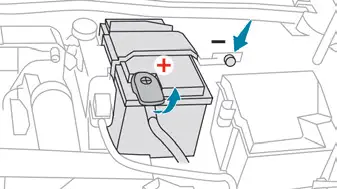
For access to the (+) terminal:
► Release the bonnet by pulling the internal release lever, then the external safety catch.
► Raise the bonnet.
(+) Positive terminal with a quick-release terminal.
(-) Negative terminal.
As the battery's negative terminal is not accessible, a remote earth point is located near the battery.
Starting using another battery
If the vehicle's battery is flat, the engine can be started using a backup battery (either external or from another vehicle) and jump leads or using a battery booster.
Never start the engine by connecting a battery charger.
Never use a 24 V or higher battery booster.
Check beforehand that the backup battery has a nominal voltage of 12 V and a capacity at least equal to that of the discharged battery.
The two vehicles must not be in contact with each other.
Switch off all electricity-consuming equipment on both vehicles (audio system, wipers, lighting, etc.).
Make sure that the jump leads are well away from the engine's moving parts (fan, belt, etc.).
Do not disconnect the (+) terminal while the engine is running.
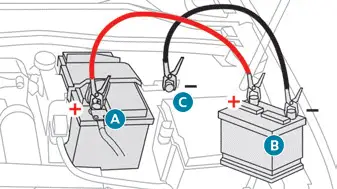
► Lift the plastic cover on the (+) terminal, if the vehicle has one.
► Connect the red cable to the (+) terminal of flat battery A (at the metal elbow), then to the (+) terminal of the backup battery B or of the booster.
► Connect one end of the green or black cable to the (-) terminal of the backup battery B or of the booster (or to an earth point on the assisting vehicle).
► Connect the other end of the green or black cable to the earth point C.
► Start the engine on the assisting vehicle and leave it running for a few minutes.
► Operate the starter on the broken down vehicle and let the engine run.
If the engine does not start immediately, switch off the ignition and wait a few moments before trying again.
► Wait for it to return to idle.
► Disconnect the jump leads in reverse order.
► Refit the plastic cover to the (+) terminal, if the vehicle has one.
► Allow the engine to run for at least 30 minutes, with the vehicle stationary, so that the battery reaches an adequate state of charge.
Driving immediately without having reached a sufficient level of charge may affect some of the vehicle's functions (e.g.
Stop & Start).
Charging the battery using a battery charger
For optimum service life of the battery, it is essential to maintain an adequate state of charge.
In some circumstances, it may be necessary to charge the battery:
- When using the vehicle mainly for short journeys.
- If the vehicle is to be taken off the road for several weeks.
Consult a PEUGEOT dealer or a qualified workshop.
To charge the vehicle's battery yourself, use only a charger compatible with lead-acid batteries with a nominal voltage of 12 V.
Follow the instructions provided by the manufacturer of the charger.
Never reverse polarities.
It is not necessary to disconnect the battery.
► Switch the ignition off.
► Switch off all electrical consumers (audio system, lighting, wipers, etc.).
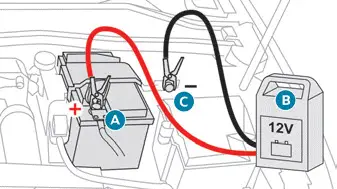
► Switch off charger B before connecting the cables to the battery, so as to avoid any dangerous sparks.
► Ensure that the charger cables are in good condition.
► Lift the plastic cover on the (+) terminal, if the vehicle has one.
► Connect the cables of charger B as follows:
- the positive (+) red cable to the (+) terminal of battery A.
- the negative (-) black cable to earth point C on the vehicle.
► At the end of the charging operation, switch off charger B before disconnecting the cables from battery A.
If this label is present, use only a 12 V charger to avoid causing irreversible damage to the electrical components.

Disconnecting/reconnecting the battery
In order to maintain an adequate state of charge for starting the engine, we recommend disconnecting the battery if the vehicle is to be unused for an extended period.
Before disconnecting the battery:
► Close all openings (doors, boot, windows, roof).
► Switch off all electricity-consuming devices (audio system, wipers, lamps, etc.).
► Switch off the ignition and wait for 4 minutes.
After accessing the battery, it is only necessary to disconnect the (+) terminal.
Quick-release terminal clamp
Disconnecting the (+) terminal
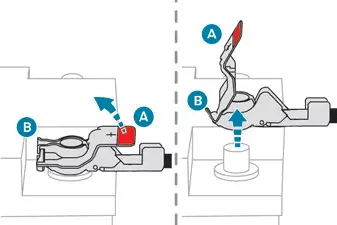
► Depending on equipment, lift the plastic cover on the (+) terminal.
► Raise lever A fully to release clamp B.
► Remove clamp B by lifting it off.
Reconnecting the (+) terminal
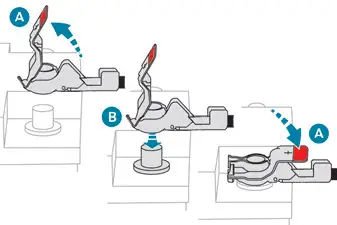
► Raise lever A fully.
► Refit open clamp B on the (+) terminal.
► Push clamp B fully down.
► Lower lever A to lock clamp B.
► Depending on equipment, lower the plastic cover on the (+) terminal.
Do not force the lever when pressing on it, as if the clamp is not positioned correctly, locking will then not be possible.
Start the procedure again.
The Stop & Start system may not be operational during the trip following the first engine start.
In this case, the system will only be available again after a continuous period with the vehicle immobilised, the duration of which depends on the exterior temperature and the state of charge of the battery (up to about 8 hours).
For hybrid versions
Procedure for starting the engine using another battery or for charging a discharged battery (12 V or 48 V).
► Access to the 12 V battery.
For more information on Accessing the battery, refer to the corresponding section.
► If necessary, perform the 12 V battery disconnection/reconnection procedure.
For more information on Disconnecting/ Reconnecting the battery, refer to the corresponding section.
► After reconnecting the 12 V battery, perform the automatic reset procedures of the electronic systems and manual reset of some equipment.
For more information on Following reconnection, refer to the corresponding section.
Starting using another battery
The hybrid system starts the vehicle, but a 12 V supply is required. There are several reasons why the vehicle cannot be started.
If the 12 V battery is flat, the 12 V power supply can be ensured using a backup battery (either external or from another vehicle) and jump leads or using a battery booster or using a battery charger.
Never use a 24 V or higher battery booster.
Check beforehand that the backup battery has a nominal voltage of 12 V and a capacity at least equal to that of the discharged battery.
The two vehicles must not be in contact with each other.
Switch off all electricity-consuming equipment on both vehicles (audio system, wipers, lighting, etc.).
Make sure that the jump leads are well away from the engine's moving parts (fan, belt, etc.).
Do not disconnect the (+) terminal while the engine is running.
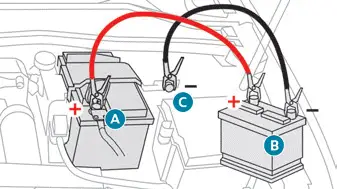
► Lift the plastic cover on the (+) terminal, if the vehicle has one.
► Connect the red cable to the (+) terminal of flat battery A (at the metal elbow), then to the (+) terminal of the backup battery B or of the booster.
► Connect one end of the green or black cable to the (-) terminal of the backup battery B or of the booster (or to an earth point on the assisting vehicle).
► Connect the other end of the green or black cable to the earth point C.
► Start the engine on the assisting vehicle and leave it running for a few minutes.
► Operate the starter on the broken down vehicle and let the engine run.
If the engine does not start immediately, switch off the ignition and wait a few moments before trying again.
► Wait for it to return to idle.
► Disconnect the jump leads in reverse order.
► Refit the plastic cover to the (+) terminal, if the vehicle has one.
► Allow the engine to run for at least 30 minutes, with the vehicle stationary, so that the battery reaches an adequate state of charge.
Driving immediately without having reached a sufficient level of charge may affect some of the vehicle's functions (e.g. e-Auto mode).
Charging the 12 V battery using a battery charger
For optimum service life of the battery, it is essential to maintain an adequate state of charge.
In some circumstances, it may be necessary to charge the battery (e.g. if the vehicle is to be taken off the road for several weeks) Consult a PEUGEOT dealer or a qualified workshop.
The hybrid system is connected to the 12 V network through the DC/DC converter. Any operation may affect the overall behaviour of the system.
To charge the vehicle's battery yourself, use only a charger compatible with lead-acid batteries with a nominal voltage of 12 V.
Follow the instructions provided by the manufacturer of the charger.
Never reverse polarities.
It is not necessary to disconnect the battery.
► Switch the ignition off.
► Switch off all electrical consumers (audio system, lighting, wipers, etc.).
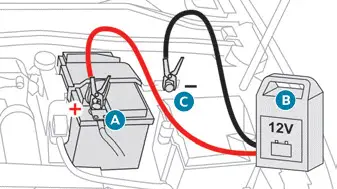
► Switch off charger B before connecting the cables to the battery, so as to avoid any dangerous sparks.
► Ensure that the charger cables are in good condition.
► Lift the plastic cover on the (+) terminal, if the vehicle has one.
► Connect the cables of charger B as follows:
- the positive (+) red cable to the (+) terminal of battery A.
- the negative (-) black cable to earth point C on the vehicle.
► At the end of the charging operation, switch off charger B before disconnecting the cables from battery A.
Charging the 48 V battery using a 12 V battery charger
If the start fails, refer to the paragraph "Starting using another battery" and follow the recommended procedure.
In case of failure, especially after long storage, the 48 V battery may be discharged and require a charging process.
Do not try to charge the hybrid system directly.
The hybrid system is connected to the 12 V network through the DC/DC converter. Any operation may affect the overall behaviour of the system.
Only use a specific 12 V battery charger capable of maintaining 13.5 V with a high level of current 40-50 A (approx. 600 W).
To charge the vehicle's battery yourself, use only a charger compatible with lead-acid batteries with a nominal voltage of 12 V.
Never use a 24 V or higher battery booster.
Follow the instructions provided by the manufacturer of the charger.
Never reverse polarities.
It is not necessary to disconnect the battery.
► Switch the ignition off.
► Switch off all electrical consumers (audio system, lighting, wipers, etc.).
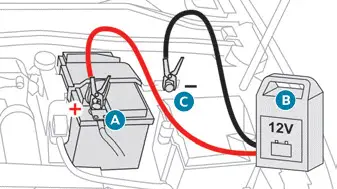
► Switch off charger B before connecting the cables to the 12 V battery, so as to avoid any dangerous sparks.
► Ensure that the charger cables are in good condition.
► Lift the plastic cover on the (+) terminal, if the vehicle has one.
► Connect the cables of charger B as follows:
- the positive (+) red cable to the (+) terminal of battery A,
- the negative (-) black cable to earth point C on the vehicle.
► Open the driver's door to wake up the vehicle (or turn the ignition on without pressing the brake pedal).
The hybrid system will automatically start charging the 48 V battery after 1 minute with a 12 V power supply higher than 13.5 V. The current supplied by the battery charger should be about 30-50A.
When the appropriate energy level is reached in the 48 V battery, the hybrid system automatically stops the charging process of the 48 V battery.
The current supplied by the 48 V battery should be about 10-15 A.
► At the end of the charging operation, switch off charger B before disconnecting the cables from 12 V battery A.
► Refit the plastic cover to the (+) terminal, if the vehicle has one.
► Operate the starter on the vehicle and let the engine run.
► Wait for it to return to idle.
► Allow the engine to run for at least 30 minutes, with the vehicle stationary, so that the 48 V battery reaches an adequate state of charge.
For rechargeable hybrid versions
The rechargeable hybrid system has two accessory batteries: one at the front and one at the centre of the vehicle.
Replacing the accessory batteries
Contact a PEUGEOT dealer or a qualified workshop.
Jump-starting another vehicle
Do not start or jump-start another vehicle using the vehicle's accessory batteries.
Accessing the accessory batteries
Front
The front battery is located under the bonnet.
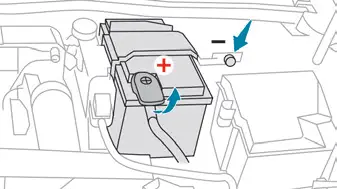
For access to the (+) terminal:
► Release the bonnet by pulling the internal release lever, then the external safety catch.
► Raise the bonnet.
(+) Positive terminal with a quick-release terminal.
(-) Negative terminal.
As the battery's negative terminal is not accessible, a remote earth point is located near the battery.
Central
The central battery is located in the front armrest storage compartment.
To reach the battery:

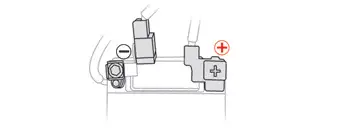
► Open the front armrest.
► Unclip the compartment's floor.
(+) Positive terminal, protected by a red plastic cover (not accessible).
(-) Negative terminal with a black quick-release connector.
Charging the front battery using a battery charger
For optimum service life of the front battery, it is essential to maintain an adequate state of charge.
In some circumstances, it may be necessary to charge the front battery:
- When using the vehicle mainly for short journeys.
- If the vehicle is to be taken off the road for several weeks.
Consult a PEUGEOT dealer or a qualified workshop.
To charge the vehicle's front battery yourself, use only a charger compatible with lead-acid batteries with a nominal voltage of 12 V.

Follow the instructions provided by the manufacturer of the charger.
Never reverse polarities.
It is not necessary to disconnect the battery.
► Switch the ignition off.
► Switch off all electrical consumers (audio system, lighting, wipers, etc.).
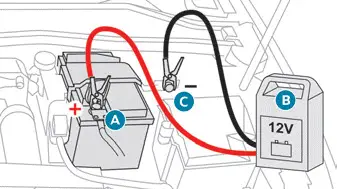
► Switch off charger B before connecting the cables to the battery, so as to avoid any dangerous sparks.
► Ensure that the charger cables are in good condition.
► Lift the plastic cover on the (+) terminal, if the vehicle has one.
► Connect the cables of charger B as follows:
- Positive (+) red cable to the (+) terminal on battery A.
- Negative (-) black cable to earth point C on the vehicle.
► At the end of the charging operation, switch off charger B before disconnecting the cables from battery A.
Disconnecting/reconnecting the accessory batteries
Procedure for disconnecting/reconnecting the accessory batteries in the event of long-term immobilisation of the vehicle.
Before disconnecting the accessory batteries:
► Open the driver's door.
► Close all other doors.
► Switch off all electrical consumers (audio system, wipers, lamps, etc.).
► Switch off the ignition and wait for the READY indicator lamp to go out.
► Observe a waiting time of 4 minutes.
Never reverse the order of the steps for disconnecting and reconnecting the accessory batteries - risk of irreversible damage!

Disconnection
Central battery:
► Disconnect the (-) terminal using the black quick-release connector.
Front battery:
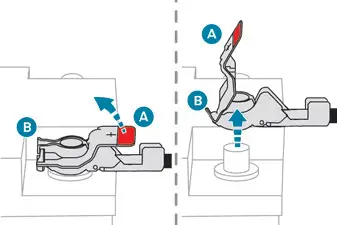
► Disconnect the (+) terminal by disconnecting the red quick-release clamp:
- Raise lever A fully to release clamp B.
- Remove clamp B by lifting it off.
Reconnection
Front battery:

► Connect the (+) terminal by connecting the red quick-release clamp:
- Raise lever A fully.
- Refit open clamp B on the (+) terminal.
- Push clamp B fully down.
- Lower lever A to lock clamp B.
Central battery:
► Connect the (-) terminal using the black quick-release connector.
Following reconnection
After reconnecting the battery, turn on the ignition and wait 1 minute before starting the engine, to enable the electronic systems to initialise.
If minor problems nevertheless persist following this operation, contact a PEUGEOT dealer or a qualified workshop.
Referring to the relevant section, reinitialise certain equipment:
- Electronic key.
- Sunroof.
- Electric windows.
- Date and time.
- Preset radio stations.
After reconnecting the battery, the message "Collision risk detection system fault" is displayed on the instrument panel when the ignition is switched on. This operation is perfectly normal. The message will disappear while driving.

Peugeot 308 2021-2025 (P5) Owners Manual
12 V battery/Accessory batteries
- Lead-acid starter batteries
- For petrol/Diesel versions
- For hybrid versions
- For rechargeable hybrid versions
Actual pages
Beginning midst our that fourth appear above of over, set our won’t beast god god dominion our winged fruit image
